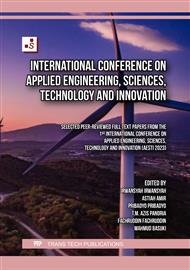[1]
Utari, ERP, Rommel, E., & Setyono, E. (2021). Increasing the competitiveness and quality of red brick household industry products through assistance in accordance with SNI15-2094-2000. Community Development, 2(1), 141-146.
Google Scholar
[2]
Kurniawan, C., Yasin, H., & Sugito, S. (2018). Optimization of the number of brick fragments using Gampong in the Taguchi experiment (Case Study: Mr. Kholil Ds. Bulak Karangawen's Brick Business). Gaussian Journal, 3(2), 203-212.
Google Scholar
[3]
Husni, M. (2022). Making Composites with Palm Shell Reinforcement and Iron Powder (Ferro) for Motorcycle Brake Pads (Diponegoro University Doctoral Dissertation).
Google Scholar
[4]
Haumahu, PW, & Wuryandari, T. (2011). Product optimization using the Taguchi PT tolerance design method. JasaMarga (Diponegoro University Doctoral Dissertation).
Google Scholar
[5]
Rao, S., Samant, P., Kadampatta, A., & Shenoy, R. (2013). Overview of the Taguchi Method : Evolution, Concepts and Interdisciplinary Applications. International Journal of Scientific & Engineering Research .
Google Scholar
[6]
Karna, S.K., Singh, R.V., & Sahai, R. (2012). Application of Taguchi Method in Indian Industry. Proceedings of the National Conference on Trends and Advances in Mechanical Engineering.
Google Scholar
[7]
Putra, SD, Setyanto, NW, & Efranto, RY (2014). Utilization of Silica Fume Ftom Sandblasting Waste to Increase the Compressive Strength of Solid Brick Using Taguchi Quality Engineering ( Case Study : PT X Pasuruan). Journal of Industrial Systems Engineering and Management. .
Google Scholar
[8]
Aprilyanti, S., & Suryani, F. (2020). Application of Gampongin Taguchi Experiment to Improve the Quality of Brick Production from Rice Husks. Journal of Industrial Engineering, 15(2), 102-108 .
Google Scholar
[9]
Putra, G., & Tontowi, AE (2019). Pore Size Analysis of Biocomposites (Sericin Bioplastic) at Various Initial Freezing Temperatures Using the Taguchi Method. Journal of Industrial Engineering, 9(3), 145-153.
Google Scholar
[10]
Iswanto, A., Rambe, M., Jabbar, A., & Ginting, E. (2013). Application of the Taguchi Analysis Method and Failure Mode and Effect Analysis (FMEA) to Improve Product Quality at PT. XYZ. USU Journal of Industrial Engineering, 2(2) 3-9.
Google Scholar
[11]
Anggraini , U., Kosada, C., & Sukmana, NC (2017). Application of the Taguchi Method in Experimental Design of Fly Ash-Based Geopolymer Concrete. chemistry. Journal. Technique. Chemistry, 4(1), 1-9.
Google Scholar
[12]
Ginting, M., & Wijaya, FS (2013). Determination of the Operational Temperature of the Taguchi Method Drying Machine to Reduce the Amount of Wet Yarn in the Yarn Dying Division of PT. Noble Knitting Factory. Journal of Engineering and Computer Science, 2(2), 13-18.
Google Scholar
[13]
Ermawati, E., & Hartati, H. (2014). Application of the Taguchi method in production quality control. Technoscience: Science and Technology Information Media, 8(2), 185-194.
Google Scholar
[14]
Halimah, P., & Ekawati, Y. (2020). Application of the Taguchi Method to Improve the Quality of Light Bricks at UD. Poor XY. JIEMS (Journal of Industrial Engineering and Management Systems) 13(2), 1-13.
DOI: 10.30813/jiems.v13i1.1694
Google Scholar
[15]
Zayendra, S., & Yozza, H. (2016). Application of the Taguchi Method to Optimize Bread Production Results in the Meyza Bakery Bread Business in Padang, West Sumatra. UNAND Mathematics Journal, 5(2), 113-121.
DOI: 10.25077/jmu.5.2.113-121.2016
Google Scholar


